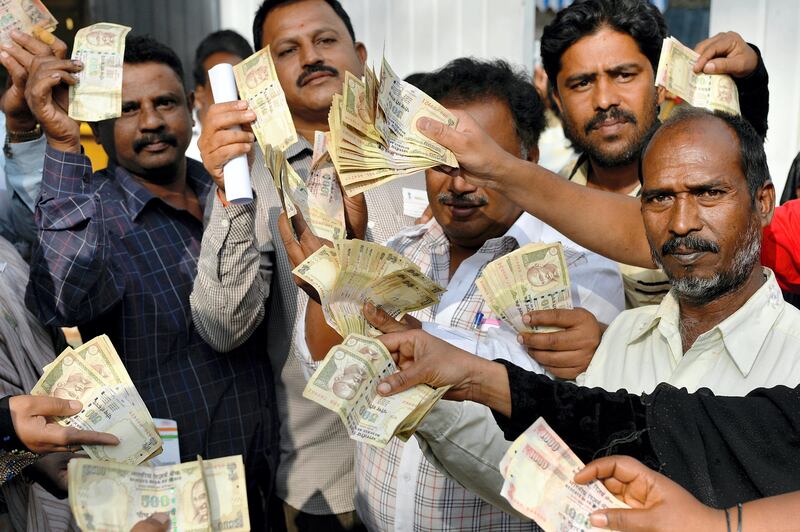New figures from India’s central bank reveal that 99 per cent of the high-value currency notes declared invalid during last year's demonetisation drive were successfully deposited back into the banking system.
The statistics come as a blow to prime minister Narendra Modi and his Bharatiya Janata Party (BJP), which had hoped demonetisation would punish Indians with undeclared stashes of cash known as “black money”.
The rationale behind the drive was that such stashes would become suddenly worthless, and anyone holding large sums of cash would be unable to deposit it in banks without filing a tax declaration about the source of the income — something that people whose cash had been earned from illegitimate sources would be reluctant to do.
As a result, the government predicted that a significant proportion of 500 and 1,000-rupee notes would not return to the banking system at all. As many as a third of currency notes of these denominations were part of black money stashes, government officials suggested.
_______________
Read more:
[ India's government yet to reveal outcome of demonetisation drive ]
[ India banknote demonetisation to hit home sales ]
_______________
But in its annual report released on Wednesday, the Reserve Bank of India (RBI) said 15.28 trillion rupees' worth of 500 and 1,000-rupee banknotes — out of a total circulating value of 15.44 trillion rupees — had flowed back into bank accounts.
On Wednesday evening, finance minister Arun Jaitley insisted that curbing black money had not been the main objective of the demonetisation drive. But that ran counter to remarks Mr Modi made when announcing the demonetisation drive last November. The intent of the drive, he said, was “to break the grip of corruption and black money”.
Mr Jaitley, however, said demonetisation had other goals: increasing electronic transactions; pulling more people into the formal banking system by encouraging them to open accounts; and crippling terrorists by cutting down on their access to cash.
He also said that the high percentage of returned currency did not in itself indicate black money offenders had escaped.
“The fact that money has got into the banking system does not mean that it is all now legitimate,” he said. “The money got identified with the owner whom henceforth had been fixed with the liability of explaining that money and facing taxation on it.”
Mr Jaitley said the government is examining 1.8 million bank accounts in which suspicious deposits — worth a total of 3-4 trillion rupees — were made. Taxes levied on these deposits, at a rate of 50-90 per cent depending on how much money had gone undeclared, could net the government 2-3 trillion rupees — a significant sum, given that tax revenues last year stood at 17.1 trillion rupees.
In theory, Mr Jaitley has a point, said John Raja, the founder of How India Lives, a company that analyses public data.
_______________
Read more:
[ Ordinary citizens feel pain from Modi's move to root out 'black money' ]
[ Indians condemn Dh270m wedding amid national cash flow crisis ]
_______________
But, he told The National: "The question is: has the government, in the past, shown the capability to crunch this kind of data and to go after suspicious transactions to retrieve tax?"
“The answer is: No.”
Even most of the 3-4 trillion rupees of deposits under review, Mr Raja said, were likely to be explained adequately by account-holders.
“India is a cash economy, and there was no law on keeping your savings as cash." After review, he said, it may well transpire that taxes had already been paid upon these deposits, or that the money was not liable to be taxed at all.
The process of serving notices for people to pay tax on deposits and working through responses and adjudication is a lengthy one. As a result, it is not entirely clear when the tax receipts from these deposits will be reflected in the government’s published tax revenue figures.
C Rammanohar Reddy, an economist and the author Demonetisation and Black Money, published in March, said the government's reckoning was off in other ways as well.
“Black money held in the form of cash is a very small proportion of total illegal wealth,” Mr Reddy said. “And those who do hold stocks of cash are powerful enough to launder it and recycle it in different ways into the banking system. That is what has happened.”
The publication of the RBI report has, however, given ammunition to Mr Modi’s critics, particularly since demonetisation and the ensuing lack of cash imposed severe hardship upon most Indians.
Between January and March, India’s economic growth slumped to 6.1 per cent — lower than both the target of 7.1 per cent and the 7.6 per cent growth seen during the same period the previous year. The slump has been attributed by several economists to the cash crunch.
Responding to the RBI report on Twitter, Rahul Gandhi, the vice-president of the opposition Congress party, called demonetisation “a colossal failure which cost innocent lives and ruined the economy", adding: "Will the [Prime Minister] own up?”
A colossal failure which cost innocent lives and ruined the economy. Will the PM own up? #DemonetisationDisaster https://t.co/YXNdW8xBTL
— Rahul Gandhi (@RahulGandhi) August 30, 2017





